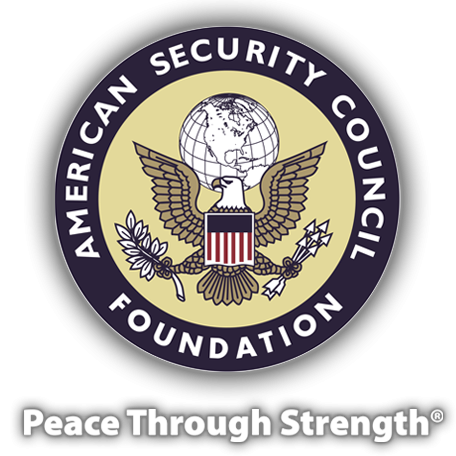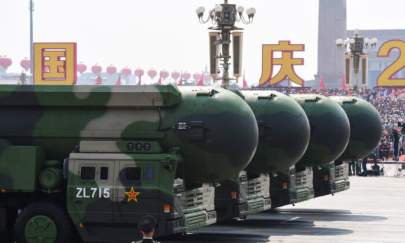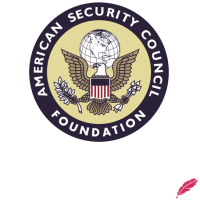US Faces Unprecedented Nuclear Threat From Allied China and Russia
Buried beneath the earth in the vast deserts of western China there are hundreds of new missile silos slated to hold deadly payloads. Some of them will house conventional weapons, others nuclear, and Western leaders don’t know which is which.
That is because China’s reigning communist regime co-locates its nuclear and conventional missiles, mixing them together and placing them under the same command centers.
The Chinese Communist Party’s (CCP) rush to build these new missile silos, and to construct nuclear weapons to occupy them, corresponds to the regime’s efforts to cement its leadership over a burgeoning bloc of anti-Western states that seek an end to U.S. hegemony in world affairs.
Or, in their terms, “multipolarity.”
According to several experts, China’s nuclear expansion combined with its de facto alliance with Russia will have far-reaching consequences for U.S. nuclear strategy, and the United States is not prepared for the change.
That is because the U.S. nuclear arsenal and strategy have only ever been designed to contend with one adversary: Russia. The extension of the nuclear threat to several unique actors is therefore one of the great strategic challenges of the 21st century, and one the United States will only get one chance to respond to.
“The United States certainly faces a significant challenge ahead as nuclear threats from not just one, but several actors, advance,” said Patty-Jane Geller, a senior policy analyst at the Heritage Foundation, a conservative think tank, in an email.
“It will need to ensure it has tailored deterrence strategies against each adversary, and find the most efficient way to develop a nuclear posture that can address multiple threats at once.”
Axis and Allies
China’s communist leadership is increasing its ties with nuclear Russia and working closely with nuclear aspirants like Iran and North Korea. More and more, those relationships are tinted with an explicitly anti-American ideological backing.
When CCP leader Xi Jinping met with Russian President Vladimir Putin in Uzbekistan for a security summit in September, their respective nations issued a joint statement, titled the “Samarkand Declaration,” vowing to pursue a “multipolar world order.”
The language of that effort is important insofar as it builds directly on vocabulary that Putin has spent using to explicitly call for the ending of the United States’ position as world leader.
“A multipolar system of international relations is now being formed,” Putin said in June.
“This is the beginning of the transition from liberal-globalist American egocentrism to a truly multipolar world.”
Despite the rhetoric, many experts have been reticent to take the growing alliance between China and Russia seriously. The two nations have a fraught history, after all, and their steadfast insistence on absolute sovereignty over internal matters means that neither side is eager to enter the sort of formal treaty that the U.S. and its allies might recognizes as an alliance.
That is changing, however, and now U.S. military leadership fears that the alliance might not only be real, but extend even to nuclear strategic cooperation.
Air Force Gen. Anthony Cotton, the nominee to head U.S. Strategic Command, told the Senate Armed Services Committee earlier in September that the United States would have to develop a strategy to contend with a unified nuclear threat from China and Russia.
“In a world where we now face two, near-peer competitors, we must deter the pacing challenge of China and address the acute threats presented by Russia,” Cotton said.
As it turns out, when nuclear weapons are on the line and hostile regimes are champing at the bit to undermine U.S. interests globally, the fragility of the China-Russia alliance is a secondary issue to the damage it could cause.
Speaking on the issue at a webinar in March, Atlantic Council senior fellow Sarah Kirchberger compared the Sino-Russian alliance to that of Hitler and Stalin in World War II.
“The question is: How much harm can [Xi and Putin] do together, even if it’s just a very short term and very opportunistic type of cooperation,” Kirchberger said.
“Because, if you look historically [at] how authoritarian countries have acted in unison, sometimes these alliances were very short term and ended abruptly, but they often caused great havoc.”
It is perhaps with that in mind that more hawkish lawmakers such as Sen. Marsha Blackburn (R-Tenn.) have taken to describing China, Russia, Iran, and North Korea as a “new axis of evil,” resurrecting the vocabulary of America’s World War II adversaries.
While the rhetoric may come across as overwrought, it does make clear that there are now, once again, two international blocs vying for drastically different world futures.
Nuclear Multipolarity Is Imminent
For Geller, the most pressing issue of this new multipolarity is the fact that U.S. nuclear arsenal and posture is only designed to contend with Russia, not China, much less both simultaneously.
“U.S. nuclear posture is currently sized to face only one peer nuclear threat (Russia), as it was designed about a decade ago based on assumptions of a more benign threat environment than we are facing today,” Geller said.
“With the emergence of China as a second nuclear peer, the United States needs a new strategy that can deter both countries at once, which it will not be able to do sufficiently in the future with the current strategy and force posture.”
That prognosis is in line with the consensus of numerous experts who have said that U.S. nuclear strategy is a bad place for securing deterrence due to the asymmetry that Sino-Russian strategic cooperation has wrought.
Indeed, U.S. military leadership has not shied away from the fact that it is not prepared to simultaneously face down both China and Russia as nuclear powers, as it has never faced such a situation in history.
Back in February, Maj. Gen. Ferdinand Stoss, director of plans and policy at U.S. Strategic Command, said that “This is the first time ever that we have a three-party nuclear peer dynamic.”
“We have no history of this,” Stoss added. “This is epic.”
Likewise, then-Joint Chiefs of Staff Vice Chairman Gen. John Hyten said in November 2021 that China’s newly tested hypersonic weapon was likely intended for nuclear first use, meaning that it would be used in a surprise attack to initiate nuclear war.
As to the question of whether the CCP and Kremlin would commit to real, joint nuclear planning, CCP officials said in September that Sino-Russian “high-level strategic cooperation” was on the table.
However fraught, tenuous, and opportunistic the relationship may be, Moscow and Beijing have joined forces against the United States, up to and including nuclear strategic cooperation.
Multipolarity by the Numbers
Russia has the largest nuclear arsenal in the world, with around 1,500 deployed nuclear weapons and more than 6,000 warheads in total. The United States, meanwhile, has about 1,400 deployed systems and 5,550 warheads. Between 1,500-2,000 warheads in both nations’ arsenals are retired and awaiting disarmament.
China is reported to have around 350 nuclear weapons, though a 2021 Pentagon report warned that the CCP was drastically increasing production and modernization of its nuclear arsenal, and that it would have at least 1,000 nuclear weapons by 2030.
The estimated number of nuclear weapons does not capture the true extent of China’s warhead stockpile, however. Some experts have questioned the numbers available, and researchers have suggested that the true number of Chinese warheads could be as high as 3,000 already.
There are several reasons for this disparity. One is the extent of the thousands of miles of underground tunnels the CCP is constructing to tend to its silos, which appears to suggest a far greater operation than previously expected.
Another is the regime’s focus on nuclear missiles that use multiple independently targetable reentry vehicles (MIRVs).
MIRVs are missile payloads that feature several warheads, each of which can be launched independently at separate targets, increasing the lethality of an individual missile many times over.
China’s DF-41 missiles, which the regime’s new silos appear constructed to house, feature a MIRV that can hold up to 10 nuclear warheads.
Add to this the fact that the DF-41 has a range of 7,500 miles, and the discovery of hundreds of new missile silos in China takes on more serious implications for U.S. nuclear strategy.
If the planned 350-400 new missile silos that China is constructing each house one DF-41 missile, it could signal an increase of 4,000 warheads to China’s arsenal, each of which would be capable of hitting its own unique target virtually anywhere in the world.
China’s ‘Nuclear Breakout’ Will Spill Over
Admiral Charles Richard, commander of the U.S. Strategic Command, described this turn of events as China’s “nuclear breakout,” an unprecedented expansion of nuclear forces that should be of significant concern to the United States.
China’s growing power not only applies a new pressure point on U.S. strategic thinking, however. It also threatens to give rise to a host of potential conflicts throughout Asia.
Geller is one of a growing number of experts who believe that China will use its nuclear arsenal to threaten, coerce, and cajole the United States away from interfering in regional conflicts.
“China’s growing nuclear arsenal will enable it to backstop its conventional aggression in the Indo-Pacific region,” Geller said. “With the backing of a stronger nuclear force, China can calculate that more aggressive actions or escalating in conventional conflicts will be less risky.”
“China’s nuclear expansion will also hinder U.S. extended deterrence efforts as allies in the region become more threatened.”
Thus, governments like those in Taiwan or Japan, or even India, will fall more prone to being targeted by CCP aggression, as the regime will consider the United States less likely to be willing to risk conflict with a strong nuclear power.
This problem is commonly referred to in international relations theory as the “stability-instability paradox.”
In essence, the paradox maintains that two nations with similar nuclear capabilities will deter one another from engaging in nuclear war for fear of mutually assured destruction, which creates stability.
The knowledge that neither side will use its nuclear weapons, however, increases the likelihood that the nations will pursue conventional warfare and indirect conflict, thus creating instability.
As such, Geller believes that a vital component of U.S. nuclear strategy ought to be avoiding a situation in which China’s nuclear power becomes so great that the regime believes it can prevent America from interfering in any conflict it may start.
“The most serious concern I believe is less so that we are at risk of China or Russia using nuclear weapons against the U.S.,” Geller said, “but that the U.S. will ultimately back down in a conflict if it does not have a credible nuclear posture and strategy.”
“To prevent this from occurring, the U.S. needs to get serious about reorienting its nuclear posture to deter two nuclear peers, and realize that business as usual will not suffice.”
China Could Coerce the United States
To some extent, some argue that China’s nuclear coercion of the United States has already begun.
Following the visit of House Speaker Nancy Pelosi to Taiwan in August, the CCP launched unprecedented military exercises. The drills encircled Taiwan, blocked international shipping lanes, and saw the launch of nuclear-capable missiles over Taiwan and into the exclusive economic zone of Japan.
Rather than meet the aggression, or work to actively curb it, the Biden administration quietly postponed its own much-needed test of a nuclear-capable missile.
“We do not believe it is in our interest, Taiwan’s interest, the region’s interests, to allow tensions to escalate further, which is why a long-planned Minuteman III ICBM test scheduled for this week has been rescheduled for the near future,” said national security spokesperson John Kirby at a press conference.
James Fanell, the former director of Intelligence and Information Operations for the U.S. Pacific Fleet, said that the episode was only the beginning of the CCP’s efforts to direct U.S. behavior.
“[China’s] new nuclear arsenal provides the CCP with the same ability to blackmail the United States from taking more forceful measures to defend our allies as we have seen Vladimir Putin do to the Biden administration in the Ukraine,” Fanell said in an email.
“Even in lesser cases, [China] could further use their nuclear weapons to force America and its allies to alter their behavior.”
Moreover, Fanell said, with each successful attempt to browbeat the United States into demurring, the likelihood that the CCP will turn to intimidation as a preferred diplomatic tactic will increase.
“These nuclear weapons will be used to threaten any nation, like the United States, from coming to Taiwan’s defense in the increasingly likely event Beijing decides to conduct a conventional invasion of Taiwan,” Fanell said.
Fanell added that the CCP would likely use its arsenal to command the ongoings of the Indo-Pacific region.
By threatening the United States with nuclear fire, the CCP could coerce it away from placing new weapons systems in Korea or Japan, or even from entering the Taiwan Strait or the first island chain, which is the first ring of archipelagos east of the Asian coastline. Such an effort could effectively halt the United States’ 187-year history of conducting freedom of navigation operations in the Indo-Pacific.
“It is not hard to imagine this kind of blackmail being used by the CCP to stop diplomatic efforts such as the AUKUS or the Quad agreements,” Fanell said, referring to two partnerships involving the United States and allies in the Indo-Pacific region.
To that end, he described China’s nuclear breakout as “the single biggest factor for destabilizing the international order since the Soviet Union began building its own nuclear arsenal in the 1950s.” And added that the regime was posturing in a similar manner to the Soviet Union, seeking to leverage its nuclear weapons to “blackmail the world to bend to its demands.”
Speaking on the same issue, Geller said that the United States’ would need to expand its nuclear capabilities to prevent China’s regional nuclear advantage from growing any further.
“The goal of the U.S. should be to show China that attempts to coerce the U.S. using nuclear threats will fail because the U.S. has the capability and will to respond to any first use of nuclear weapons,” Geller said.
“To accomplish this, the U.S. will need to fill the perceived deterrence gap that now exists in regional nuclear capabilities.”
Tactical Nuclear Weapons Needed
In contemplating what was necessary to restore a credible U.S. nuclear deterrent in a multipolar world, both Fanell and Geller came to the same conclusion: adapt or die.
“Given the dramatic change in the status quo … in the Pacific, the United States’ number one priority must be in the rapid fielding of a credible and robust nuclear arsenal,” Fanell said.
“In response to this new reality, the United States must dust off its previously learned policies and postures from the Cold War with the Soviet Union,” Fanell said.
Fanell added that the United States needed to expand its arsenal of strategic nuclear weapons across the triad of land, sea, and, air capabilities, and also to invest large sums into the fielding of tactical nuclear weapons to be positioned in Japan, Korea, and even Taiwan.
Perhaps no capability was more vital to this effort, he said, than the nuclear sea-launched cruise missile (SLCM-N).
The SLCM-N, a submarine-based tactical nuclear weapon, has been recommended by military leaders since the 2018 Nuclear Posture Review, but was nevertheless scrapped by the Biden administration that feared escalating tensions with China.
“One of these areas [of needed capabilities] regards the fielding of afloat nuclear naval weapons, like the SLCM-N, which the U.S. Navy has unwisely cut research and development funding and for which the Biden Administration remains positioned to eliminate,” Fanell said.
“Instead of killing this program, the current administration should be seeking to enhance the speed with which the SLCM-N is fielded, but should also be looking for other ways to modernize and increase America’s nuclear arsenal.”
Geller agreed, adding that the United States would need to demonstrate both the capability and the will to field nuclear weapons in order to deter China—something that the administration appeared hesitant to do.
“Fielding weapons like the SLCM-N can help show China that the U.S. has a proportional, credible option at this lower level of the escalation ladder,” Geller said.
“The U.S. also needs to demonstrate the will to show strength when needed. Postponing a routine missile test in the face of Chinese aggression toward Taiwan, as one example, only hindered this effort.”
With the international order itself hanging in the balance, Fanell said that the United States’ national security efforts had already been hampered by the burgeoning multipolar order led by China and Russia.
Now, he said, that security needed to be restored—A feat only possible through the forward deployment of new, tactical nuclear weapons.
“These may seem like provocative measures,” Fanell said, “but when measured against the backdrop of [China’s] nuclear breakout this past 20 months, and Vladimir Putin’s nuclear blackmail over Ukraine, the U.S. does not have a moment to lose in restoring national security.”
The Epoch Times has requested comment from the White House and Pentagon.












